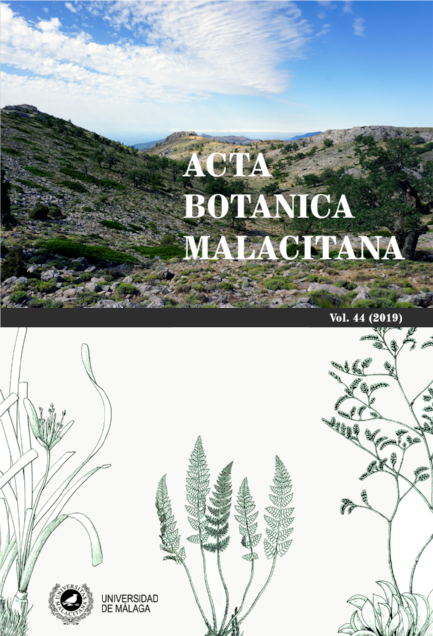Juniperus turbinata Guss. (Cupressaceae), novedad para la flora de Extremadura (España)
DOI:
https://doi.org/10.24310/abm.v44i0.5386Abstract
Juniperus turbinata Guss. (Cupressaceae), a new record for the flora of in Extremadura (Spain)
Palabras clave. Extremadura, Juniperus turbinata, Península Ibérica, sabinares.
Key words. Extremadura, Juniperus turbinata, Iberian Peninsula, juniper schrublands.
Downloads
Metrics
References
Adams, R.P. (2014). Junipers of the world: The genus Juniperus (4th ed.). Bloomington IN: Trafford Publications.
Albarreal Núñez, J., & Romero Zarco, C. (2004). Novedades corológicas para Andalucía Occidental (Sevilla-Cádiz). Acta Botanica Malacitana, 29, 300-304.
Arista, M., & Ortiz, P.L. (1995). Juniperus phoenicea subsp. turbinata en La Sierra de Grazalema. Acta Botanica Malacitana, 20, 303-304.
Asensi, A., Díez-Garretas, B., & Quézel, P. (2007). Plant communities of Juniperus turbinata Guss. subsp. turbinata in the Mediterranean Region. A biogeographical, bioclimatical and syntaxonomical survey. Phytocoenologia, 37, 599-623. DOI: 10.1127/0340-269X/2007/0037-0599
Bacchetta, G. (2006). Flora vascolare del Sulcis (Sardegna Sud-Occidentale, Italia). Guineana, 12, 1-369.
Boraty?ski, A., Lewandowski, A., Boraty?ska, K., Montserrat, J.M., & Romo, A. (2009). High level of genetic differentiation of Juniperus phoenicea (Cupressaceae) in the Mediterranean region: Geographic implications. Plant Systematic and Evolution, 277, 163-172. DOI: 10.1007/s00606-008-0122-z
Capelo, J.H., Lousã, M.F., & Costa, J.C. (1994). Phlomido purpureae-Juniperetum turbinatae, ass. nova: uma nova comunidade de Juniperus turbinata Guss. ssp. turbinata em xisto na bacia hidrográfica do rio Guadiana. Anais do Instituto Superior de Agronomia, 44, 515-530.
Charco, J. (2001). Guía de los árboles y arbustos del Norte de África. Madrid, MA: Agencia Española de Cooperación Internacional, Ministerio de Asuntos Exteriores.
Díez-Garretas, B., Asensi, A., & Martín Osorio, V.E. (1996). Comportamiento fitosociológico de Juniperus phoenicia L. s.l. en el sur de la Península Ibérica. Lazaroa, 16, 159-167.
Fernández Palacios, J.M., de Nascimento, L., Otto, R., Delgado, J.D., García del Rey, E., Arévalo, J.R., & Whittaker, R.J. (2011). A reconstruction of Palaeo-Macaronesia, with particular reference to the long-term biogeography of the Atlantic island laurel forests. Journal of Biogeography, 38(2), 226-246. DOI: 10.1111/j.1365-2699.2010.02427.x
Franco, J.A. (1986). Juniperus L. In S. Castroviejo, M. Laínz, G. López González, P. Montserrat, F. Muñoz Garmendia, J. Paiva, & L. Villar (Eds.), Flora iberica (Vol. 1, pp. 181–188). Madrid, MA: Real Jardín Botánico.
Gianguzzi, L., Ilardi, V., Cardella, O., Cusimano, D.,
Cuttonaro, P., & Romano, S. (2012). Phytosociological characterization of the Juniperus phoenicea L. subsp. turbinata (Guss.) Nyman formations in the Italo-Tyrrhenian Province (Mediterranean Region). Plant Sociology, 49, 3-28. DOI: 10.7338/pls2012492/01
Hidalgo, N., & Pérez Latorre A.V. (2013). Vegetación y flora de la Sierra de Cártama (Valle del Guadalhorce, Málaga, España). Acta Botanica Malacitana, 38, 119-149.
Instituto Geológico y Minero de España (1986): Mapa geológico de España E. 1:200.000 (Talavera de la Reina). Madrid, MA: IGME.
Ivanov, D., Utescher, T., Mosbrugger, V., Syabryaj, S., Djordjevi?-Milutinovi?, D., & Molchanoff, S. (2011). Miocene vegetation and climate dynamics in Eastern and Central Paratethys (Southeastern Europe). Palaeogeography, Palaeoclimatology and Palaeoecology, 304, 262-275. DOI: 10.1016/j.palaeo.2010.07.006
Lebreton, P., & Pérez de Paz, P.L. (2001). Définition du Genévrier de Phénicie (Juniperus aggr. phoenicea), reconsidéré à ses limites biogéographiques: Méditerranée orientale (Créte et Chypre) et Atlantique (Iles Canaries). Bulletin Mensuele de la Societe Linneenne de Lyon, 70(4), 73-92.
López González, G. (2001). Los árboles y arbustos de la Península Ibérica e Islas Baleares. 2 vol. Madrid-Barcelona-México: Mundi-Prensa.
Mao, K., Hao, G., Liu, J., Adams, R.P., & Milne, R.I. (2010). Diversification and biogeography of Juniperus (Cupressaceae): Variable diversification rates and multiple intercontinental dispersals. New Phytologist, 185, 332-342. DOI: 10.1111/j.1469-8137.2010.03351.x
Mazur, M., Minissale, P., Sciandrello, S., & Boraty?ski, A. (2016). Morphological and ecological comparison of populations of Juniperus turbinata Guss. and J. phoenicea L. from the Mediterranean region. Plant Biosystems, 150, 313-322. DOI: 10.1080/11263504.2014.994579
Mazur, M., Zieli?ska, M., Boraty?ska, K., Romo, A., Salva-Catarineu, M., Marcysiak, K., & Boraty?ski, A. (2018). Taxonomic and geographic differentiation of Juniperus phoenicea agg. based on cone, seed, and needle characteristics. Systematics and Biodiversity, 16, 469-482. DOI: 10.1080/14772000.2018.1439120
Médail, F., & Diadema, K. (2009). Glacial refugia influence plant diversity patterns in the Mediterranean Basin. Journal of Biogeography, 36, 1333-1345. DOI: 10.1111/j.1365-2699.2008.02051.x
Pérez Latorre, A.V., Gavira, O., & Cabezudo, B. (2006). Notas sobre la vegetación de Andalucía VII. Acta Botanica Malacitana, 31, 178-180.
Downloads
Published
How to Cite
Issue
Section
License
All information related to the licensing of published works in Acta Botanica Malacitana and copyright can be found in our Editorial Policy.







1.png)
